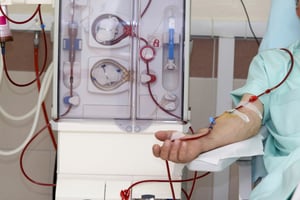All Surveillance Is Not the Same
Ultrasound indicator dilution is the current Gold Standard for measurement of vascular access recirculation and access flow;1
- Ultrasound indicator dilution is the method of choice for monthly surveillance of
 vascular access grafts in adherence to NKF-K/DOQI guidelines
vascular access grafts in adherence to NKF-K/DOQI guidelines - Available evidence suggests that access flow measurements are the best tests currently available to screen for access dysfunction.
- Monthly surveillance is a cost-effective strategy.
In 1991, Biomedical Engineer Nikolai Krivistki PhD DSc arrived at Transonic’s doors from Moscow’s USSR’s Medical Academy’s National Research Center for Surgery. After joining Transonic Systems, he spent his first several months familiarizing himself with Transonic’s products, especially its proprietary clamp-on tubing flowsensors and dedicated tubing flowmeter.
In an ‘Aha’ moment Nikolai suddenly envisioned how existing transit-time ultrasound technology could be combined with classical indicator dilution technology with which he was most familiar to provide a superior flow measurement. He termed this innovation “ultrasound indicator dilution” technology.
As he pondered real-life blood flow measurement problems of hemodialysis patients that had been communicated to him by Drs. Thomas Depner and Jeffrey Sands, Nikolai had another “Aha” insight. He realized that vascular access flow could be measured with ultrasound dilution technology by simply reversing the dialysis bloodlines and injecting saline into the venous sensor. This was the very quantitative measurement that, until to that time, had eluded clinicans. Dr. Krivitski’s direct vascular access flow measurement revolutionized hemodialysis over the next decade. The first patents of the “Krivitski Method” were filed in the fall of 1994.
The innovative technology took off like a storm. It gave clinicians answers they wanted. Within four years, ultrasound indicator dilution technology was recognized in the Guidelines of the American Kidney Foundation as the Gold Standard technology, or the technology by which all other measurements should be compared and judged.
Awards followed including the prestigious US Small Business Administration’s “Tibbets Award” for Research and Innovation presented in a White House breakfast ceremony in 2000. The technology also spurred an avalanche of publications that reported on the value of access flow measurements in assessing hemodialysis effectiveness and predicting the advent of a stenosis within the access. The measurements made possible by Dr. Krivitski’s aha insights have become the cornerstone of many vascular access quality programs.




